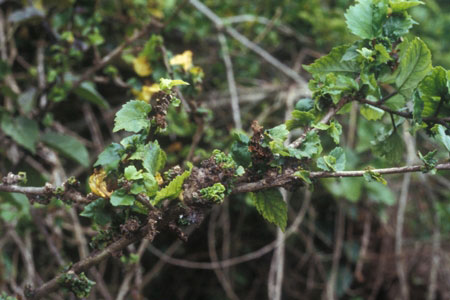Home » Bugs » Lawn Pests »
Active Seasons




Pink Hibiscus Mealybug Size and Appearance Facts
Pink hibiscus mealybugs are native to tropical and subtropical regions, including several parts of Florida and Texas. These pests feed on many plants and bushes, injecting toxic saliva that can kill plants or stunt their growth, making them a real nuisance in gardens and on farms. Think you’re dealing with this pest? Pink hibiscus mealybugs exhibit these characteristics:
- Incredibly small in size, just 1/10 of an inch (or three millimeters)
- Typically pinkish brown in color but often covered in a cotton-like wax
- Often cluster together on leaves
- Lay eggs in groups, which are similar in color
- Oval-shaped bodies with two antennae
- Clusters of pink hibiscus mealybugs can look like white mold
Identifying Pink Hibiscus Mealybugs From Other Lawn Pests
While the pink hibiscus mealybug is relatively unique, it can often be confused for other small bugs that gather on plants, like coconut mealybugs and cottony cushion scales. While the coconut mealybug is incredibly similar in size, shape, and behavior, it lacks the pinkish-brown color of the pink hibiscus mealybug.
Though the cottony cushion scale shares the fluffy white appearance of the pink hibiscus mealybug, this scale insect is typically much bigger and vastly different in shape. Cottony cushion scale bugs look a bit like white shells with a ridged appearance.
We provide pest control for pink hibiscus mealybugs in the following locations and their surrounding areas:

Behavior and Habitat of Pink Hibiscus Mealybugs
Pink hibiscus mealybugs form colonies on plants, with a female mealybug laying as many as 500 eggs at a time or more. The bugs feed on the sap in trees, plants, and ornamental flowers while injecting their toxic saliva into the plant they’re feeding on. The pink hibiscus mealybug is known to make its habitat in more than 125 different plant species.

Signs of Infestation of Pink Hibiscus Mealybugs
If you’re dealing with an infestation, stay vigilant for some key signs of pink hibiscus mealybugs, including white spots on plants, bunching or crinkling leaves, shriveling flower buds, and smaller fruits than usual. In rare cases, these bugs can even kill plants and trees altogether. Occasionally, you can unwittingly bring an infestation onto your lawn or into your garden through an infected plant you bring home from a garden store or nursery.

Tips for Prevention of Pink Hibiscus Mealybugs
Getting Rid of Pink Hibiscus Mealybugs
Unlike other pests, applying over the counter pesticides can actually be counterproductive in treating pink hibiscus mealybug infestations, as pesticides kill natural predators of the pest, such as ladybugs, mites, and whiteflies. When DIY does not give the intended result, turn to Hulett, who can provide professional pest control services for pink hibiscus mealybugs and other garden and lawn pests.
Effective Pink Hibiscus Mealybug Control Solutions
Here at Hulett, we are familiar with pink hibiscus mealybugs and equipped with top-of-the-line treatment methods. We provide pink hibiscus mealybug control and removal services in Florida, as well as many more pest control services. Check our Florida pest control service areas to see if we cover your home.
Get started today by scheduling your free pest inspection. Dealing with a different pest? Check out our pest library, where you can find all the pests we treat, along with helpful information for identifying pests in your home or yard. For additional information on our Florida pest control services, check out our FAQ.

